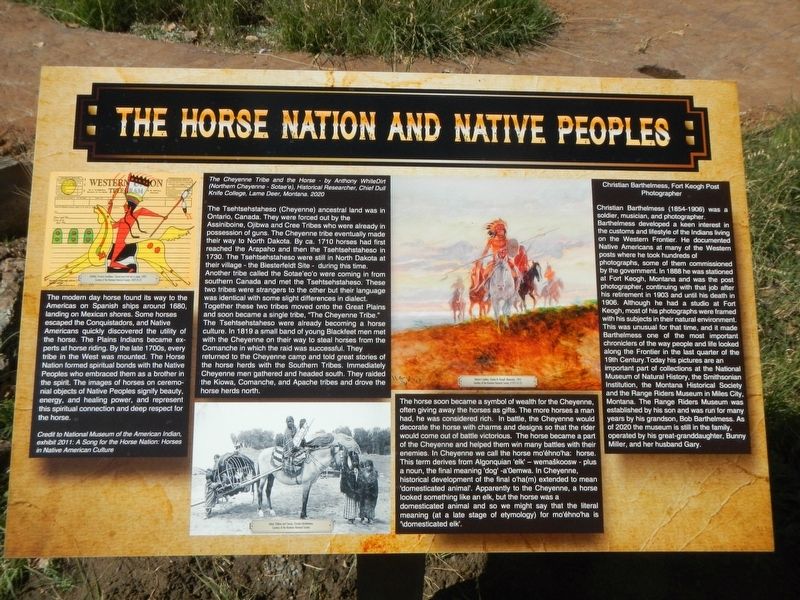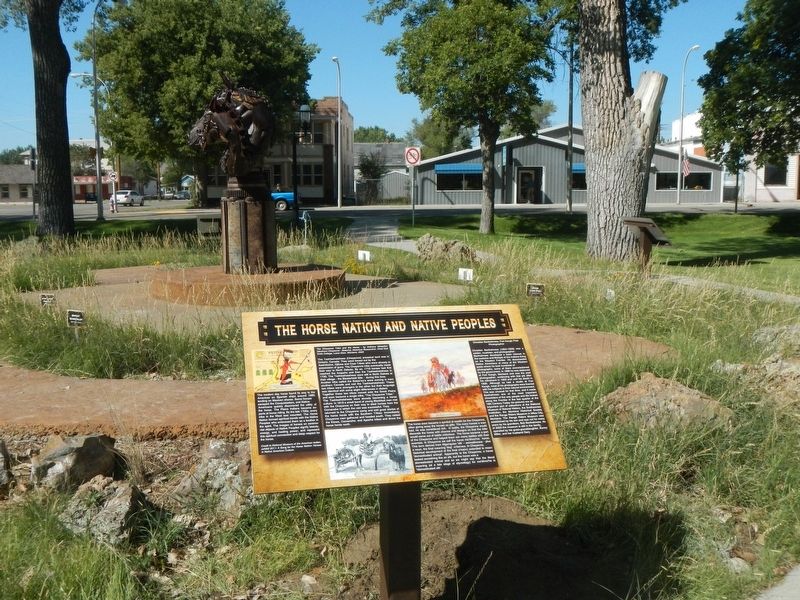Miles City in Custer County, Montana — The American West (Mountains)
The Horse Nation and Native People

Photographed By Barry Swackhamer, September 11, 2020
1. The Horse Nation and Native People Marker
Captions: (top left) Untitled, T(?) Guardpea, Colored pencil and ink on paper, 2009; (bottom center) Indian Children and Travois, Christian Bartheless; (upper center) Nature;s Soldiers, Charles M. Russell, Waterclor, 1903.
The Tsehtsehstaheso (Cheyenne) ancestral land was in Ontario, Canada. They were forced out by the Assiniboine, Ojibwa and Cree who were already in possession of guns. The Cheyenne tribe eventually made their way to North Dakota. By ca. 1710 horses had first reached the Arapaho and then the Tsehtsehstaheso in 1730. The Tsehtsehstaheso were still in North Dakota at their village - the Biesterfeldt Site - during this time. Another tribe called the Sotae'eo'o were coming in from southern Canada and met the Tsehtsehstaheso. These two tribes were strangers to the others, but their language was identical with some slight differences in dialect. Together these two tribes moved onto the Great Plains and soon became a single tribe, "The Cheyenne Tribe." The Tsehtsehstaheso were already becoming a horse culture. In 1819 a small band of young Blackfeet men met with the Cheyenne on their way to steal horses from the Comanche in which the raid was successful. They returned to the Cheyenne camp and told great stories of the horse herds with the Southern Tribes. Immediately Cheyenne men gathered and headed south. They raided the Kiowa, Comanche, and Apache tribes and drove the horse herds north.
The horse soon became a symbol of wealth for the Cheyenne, often giving away the horses as gifts. The more horses a man had, he was considered rich. In Battle, the Cheyenne would decorate the horses with charms and designs so that the rider would come out of battle victorious. The horse became a part of the Cheyenne and helped them win many battles with their enemies. In Cheyenne as we call the horse mo'éhno'ha: horse. This term derives from Algonquian 'elk' - wemaškoosw - plus a noun, the final meaning 'dog'-a'Oemwa. In Cheyenne, historical development of the final o'ha(m) extended to mean 'domesticated animal'. Apparently to the Cheyenne, a horse looked something like and elk, but the horse was a domesticated animal and so we might say that the literal meaning (at a late stage of etymology) for mo'éhno'ha is '\domesticated elk'.
Christian Barthelmess (1854-1906) was a soldier, musician, and photographer. Barthelmess developed a keen interest in the customs and lifestyle of the Indians living on the Western Frontier. He documented Native Americans at many of the Western posts where he took hundreds of photographs, some of them commissioned by the government. In 1888 he was stationed at Fort Keogh, Montana and was the post photographed, continuing with the job after his retirement in 1903 and until his death in 1906. Although he has a studio at Fort Keogh, most of his photographs were framed with his subjects in their natural environment. This was unusual for that time, and it made Barthelmess one of the most important chroniclers of the way people and life looked along the Frontier in the last quarter of the 19th Century. Today his pictures are an important part of collections at the National Museum of Natural History, the Smithsonian Institution, the Montana Historical Society and the Range Riders Museum in Miles City, Montana. The Range Riders Museum was established by his son and was run for many years by his grandson, Bob Bartheless. As of 2020 the museum is still in the family, operated by his great-granddaughter, Bunnu Miller, and her husband Gary.
Credit to National Museum of the American Indian, exhibit 2011: A Song for the Horse Nation: Horses in Native American Culture.
Erected by Range Riders Museum.
Topics. This historical marker is listed in these topic lists: Animals • Communications • Native Americans.
Location. 46° 24.305′ N, 105° 51.133′ W. Marker is in Miles City, Montana, in Custer County. Marker is on Main Street near South 5th Street, on the right when traveling east. The marker is in Riverside Park. Touch for map. Marker is in this post office area: Miles City MT 59301, United States of America. Touch for directions.
Other nearby markers. At least 8 other markers are within walking distance of this marker. Photography (here, next to this marker); The Chappel Brothers Corporation (here, next to this marker); Early Horse History (a few steps from this marker); Riverside Park Steamboats (within shouting distance of this marker); The Olive Hotel (about 400 feet away, measured in a direct line); Dr. Redd's Brick Building (about 400 feet away); Commercial Block (about 400 feet away); Miles City Main Street Historic District (about 700 feet away). Touch for a list and map of all markers in Miles City.
Also see . . . How the Indian Got the Horse -- American Heritage (February 1964). The process by which the native tribes adopted the animal, and consequently were able to hold the land against all intruders until the destruction of the buffalo herds starved them into submission, has been the subject of much speculation and dispute. (Submitted on January 1, 2021, by Barry Swackhamer of Brentwood, California.)
Additional keywords. photographer
Credits. This page was last revised on January 1, 2021. It was originally submitted on January 1, 2021, by Barry Swackhamer of Brentwood, California. This page has been viewed 358 times since then and 65 times this year. Photos: 1, 2. submitted on January 1, 2021, by Barry Swackhamer of Brentwood, California.
